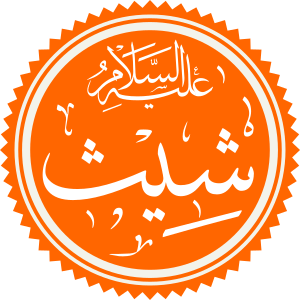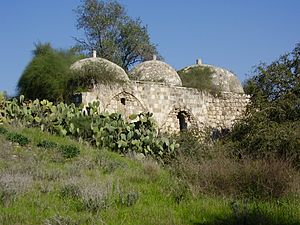Seth facts for kids
Quick facts for kids Seth the Patriarch |
|
|---|---|
 |
|
| Holy Forefather and Antediluvian Patriarch | |
| Born | 130 AM |
| Died | 1042 AM (aged 912) (place of death disputed) |
| Venerated in | Judaism Christianity Islam Mandaeism |
| Major shrine | Disputed |
Seth (also spelled Shēth) is a very important person in several religions. He is known in Judaism, Christianity, Islam, and Mandaeism. Seth was the third son of Adam and Eve, who were the first humans. He was born after his brother Abel was killed by their other brother, Cain. Eve believed that God gave her Seth to replace Abel.
Contents
Seth in the Bible
According to the Book of Genesis in the Bible, Seth was born when Adam was 130 years old. The Bible says Seth was "a son in his likeness and image." This means he was very much like Adam. Adam had many other sons and daughters before he died at 930 years old. Seth himself lived to be 912 years old. He died about 14 years before Noah was born. Seth is important because he is an ancestor of Noah, and through Noah, he is an ancestor of all people alive today.
Ancient Jewish Stories
Seth appears in old Jewish writings called the Life of Adam and Eve. These stories tell about Adam and Eve's lives after they left the Garden of Eden. In one story, Seth and Eve go to the Garden's entrance. They want to ask for special oil from the Tree of Life. On their way, a wild animal attacks Seth. But the animal leaves when Seth tells it to. An angel named Michael tells them they cannot have the oil yet. He promises it will be given at the end of time.
Later, only Seth is able to see Adam being taken up to heaven. Adam is carried in a special chariot to the Garden of Eden.
Jewish tradition says that Adam shared secret teachings with Seth. These teachings later became part of a mystical tradition called the Kabbalah. Seth is seen as the ancestor of all good and righteous people. Some stories say Seth had 33 sons and 23 daughters.
Josephus's Writings
Josephus, an ancient historian, wrote about Seth in his book Antiquities of the Jews. He described Seth as a good and excellent person. Josephus said that Seth's family learned a lot about the stars and heavens. They built two special pillars to record their discoveries. These "pillars of the sons of Seth" were made to last through disasters. Adam had predicted that the world would be destroyed by fire and by a great flood. So, Seth's descendants built one pillar of brick and one of stone. If the brick pillar was destroyed, the stone one would remain. Josephus claimed that the stone pillar was still standing in his time.
Some people, like the translator William Whiston, thought Josephus might have confused Seth with an Egyptian king. They also believed that no pillars could have survived the great flood.
Seth in Christianity
The Book of Jubilees, another ancient text, says Seth was born when Adam was 130 years old. It also says that Seth married his sister, Azura, when he was 231 years old. Azura was four years younger than Seth. They had a son named Enos four years later.
Seth is honored as one of the Holy Forefathers in some Christian churches. The Genealogy of Jesus in the Bible also includes Seth.
There was a group called the Sethians who were a type of early Christian group. They greatly respected Seth. They believed he was a special divine being. They thought Seth's descendants were a superior group of people.
Seth in Islam

In Islam, Seth (called Shēth ibn Adam) is highly respected. He is seen as Adam and Eve's third and righteous son. Muslims believe he was a gift from God after Abel's death. Many Islamic scholars say Seth was a prophet, just like his father Adam. He continued to teach God's laws to people after Adam died. Some sources say Seth received special scriptures from God. These are thought to be the "first scriptures" mentioned in the Quran.
Islamic stories say Seth was born when Adam was over 100 years old. Adam chose Seth to guide his people. Seth is believed to have had wisdom about time and future events, like the Great Flood. Many traditional crafts, like making horn combs, are linked back to Seth.
Some Muslims believe Seth's tomb is in a village called Al-Nabi Shayth in Lebanon. There is a mosque there named after him. Another tradition places his tomb in the Palestinian village of Bashshit. This village was later depopulated, but the structure believed to be his tomb still exists in the Israeli moshav Aseret. There is also a tomb in Afghanistan identified as Seth's burial site.
Seth in Mandaeism
In Mandaeism, Seth is known as Sheetil (or Shitil). He is seen as an angelic figure and a prophet. He is sometimes called a son of Adam, or a brother or father of other important figures like Anush and Hibil. Sheetil is considered one of the people who revealed the Mandaean religion.
Seth in Yazidism
In Yazidism, Seth is known as Shehid ibn Jerr. Yazidis have a unique belief about how they came to be. They say that Adam and Eve each put their seeds into separate jars. Eve's seed became insects. But Adam's seed became Shehid ibn Jerr, who is the ancestor of the Yazidis. Because of this, Yazidis believe they were created differently from all other humans.
Family Tree
| Adam | Eve | ||||||||||||||||||||||||||||||||||||||||||||
| Cain | Abel | Seth | |||||||||||||||||||||||||||||||||||||||||||
| Enoch | Enos | ||||||||||||||||||||||||||||||||||||||||||||
| Irad | Kenan | ||||||||||||||||||||||||||||||||||||||||||||
| Mehujael | Mahalalel | ||||||||||||||||||||||||||||||||||||||||||||
| Methushael | Jared | ||||||||||||||||||||||||||||||||||||||||||||
| Adah | Lamech | Zillah | Enoch | ||||||||||||||||||||||||||||||||||||||||||
| Jabal | Jubal | Tubal-Cain | Naamah | Methuselah | |||||||||||||||||||||||||||||||||||||||||
| Lamech | |||||||||||||||||||||||||||||||||||||||||||||
| Noah | |||||||||||||||||||||||||||||||||||||||||||||
| Shem | Ham | Japheth | |||||||||||||||||||||||||||||||||||||||||||
Shrines
People in different places believe they have the tomb of Seth.
Iraq
On July 26, 2014, a group called the Islamic State of Iraq and the Levant (ISIL) destroyed the Nabi Shiyt (Prophet Seth) shrine in Mosul, Iraq. They also took some valuable items from the shrine.
Lebanon

There is a village in Lebanon named Al-Nabi Shayth or Al-Nabi Sheeth, which means "The Prophet Seth." This village is believed to contain his shrine.
Palestine

There was a village in central Palestine called Bashshit, named after Seth. In this village, there was, and still is, a shrine believed to be his tomb. The tomb is now in a park in the middle of the settlement of Aseret.
See also
 In Spanish: Set (personaje bíblico) para niños
In Spanish: Set (personaje bíblico) para niños
- Set (deity) or Seth, an Egyptian deity

